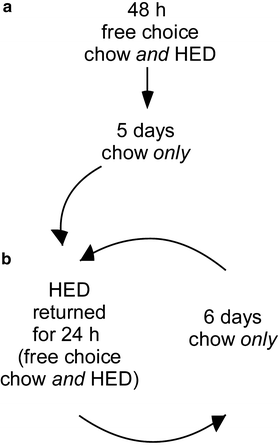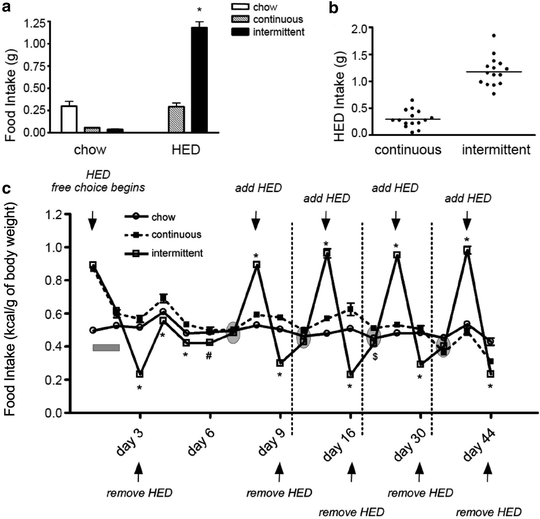Fig. 1.
Daily 1-h free-choice access to a palatable, energy dense diet induces binge-like eating in mice. (a) In 129SvEv mice, 1-h intake of a highly-palatable diet (labeled HP on y-axis) increases steadily with each subsequent exposure, until it reaches a plateau after approximately 10 days. (b) However, consumption of the standard chow diet declines so that 24-h caloric intake remains similar to chow-only fed controls. Also shown are results in Neuropeptide-Y (NPY) knockout mice. NPY knockout mice take longer to reach maximal 1-h intakes compared to wild-type controls, suggesting that this strain has deficits in acquiring this binge-like eating behavior. Reprinted with permission from (18).
As the mice have free access daily to chow and HED, this method can be used to access palatability cues in knock-out mice (18). One limitation of the model is that access to HED is predictable and likely entrains anticipatory activity to the HED access. Moreover, the mechanism driving the feeding behavior on a daily intermittent access schedule is likely distinct from the feeding in response to caloric restriction used in previous models. Interestingly, once stable 1-h HED intakes are established, this intake is hard to extinguish. Even after a 3-week period where no HED is presented, the 1-h HED intake will reestablish itself back to similar levels upon return of HED access (DK Sindelar, unpublished observations). Thus, once the behavior is established, wash-out periods following pharmacological manipulation can be performed without having to retrain or use a naïve group of mice, allowing the investigator to perform multiple experiments within the same cohort of mice. It should be noted that investigators should be cautious when working with genetically engineered mice (GEM) until caloric intake studies are performed and baseline results compared to appropriate wild-type control mice.
2.2.2 Weekly 24-h, Free-Choice Access Schedule
The procedure used to initiate and maintain binge-eating behavior with once weekly access is outlined in Fig. 2 (13). Adult mice should be randomized by body weight into one of three experimental groups. The chow-only and continuous HED access groups serve as controls. Chow-fed mice receive continuous access to a standard low-fat chow diet (e.g., TD2014, 13% fat, 67% carbohydrate, 2.9 kcal/g, Teklad, Madison, WI). Mice in the continuous access group receive continuous free-choice access to both the standard low-fat chow diet and HED (e.g., Teklad 95217, 39.8% fat, 16% sucrose, 4.3 kcal/g). Mice in the intermittent binge group receive an initial 48-h free-choice access to both chow and the HED to prevent neophobia to the diet. After 48 h, the HED is removed for 5 days, during which time only the standard chow is available. This provides sufficient time for chow intake to return to levels measured prior to HED access. The HED is then presented back to the rodent approximately 4 h into the light cycle, and intakes of both the chow and HED are monitored at 2.5-h and 24 h after HED presentation. The 2.5 h time point represents the most rapid rate of consumption and is defined as the binge-eating period. The 24-h time point is used to monitor any compensatory changes in caloric intake that may occur following the binge eating episode. Following the 24 h of free-choice access to both chow and the HED, the HED is removed from mice in the binge group completing binge cycle #1. For subsequent binge cycles, animals have 6 days of access to chow only (again to allow daily caloric intake values to return to “normal” levels), followed by another 24 h of free-choice access to both diets.


Fig. 2.
Method to induce binge-like eating in mice with weekly 24-h free-choice access. (a) Beginning of binge cycle #1: initial 48-h access to the high-energy diet (HED), then 5 days of ad libitum chow only before access to the HED for 24 h. (b) Successive binge cycles: mice in the intermittent group have free choice access to standard chow and HED once weekly for 24 h. A chow control group has ad libitum access to a standard chow diet, and a continuous access control group has ad libitum access to both the standard chow and HED (not shown). Reprinted with permission from (13).
It should be pointed out that animals in the binge group are never deprived of chow. A significantly reduced amount of chow intake is commonly observed following the removal of HED. However, the amount of chow intake is completely determined by the mice and not the investigator. With this weekly access paradigm, we have been able to obtain reliable binge-like eating during the first binge cycle. Interestingly, as long as the HED is present mice do not compensate by reducing their nocturnal intake. Thus, 24-h food intakes remain significantly elevated after access to the HED in the binge group. Typical food intakes within 2.5 h after receiving the HED are shown in Fig. 3. During this time period, mice consume approximately 33% of their typical daily caloric intake. We have been able to maintain consistent binge-like eating behavior for at least 6 weeks in male mice using this model (Fig. 3)


Fig. 3.
Typical 2.5-h and 24-h food intakes after presentation of a palatable, energy dense diet (HED) in mice with weekly 24-h free-choice access. (a) Mice consume approximately 33% of their total daily caloric intake in the 2.5 h following presentation of the HED. (b) Scatter plot showing uniform preference of the HED in all mice. (c) Shown are 24-h kcal intakes. Stable binge eating was able to be obtained for at least 6 successive weeks. The shaded horizontal rectangle indicates initial 48-h exposure to the HED and shaded ovals highlight the 24-h chow intake immediately preceding access to the HED. Data are from male C57BL/6 mice. (Bonferroni post hoc tests *p < 0.001, $ p < 0.01, # p < 0.05; continuous vs. intermittent binge groups). Reprinted with permission from (13).
2.3 Time Required
When using the daily 1-h free-choice access schedule, several days are necessary to obtain reliable binge eating. In some cases, particularly when working with GEM, it may be necessary to have an initial 24 h exposure to the HED to reduce neophobia to the diet 1 week prior to initiating daily access. This prior exposure should significantly increase HED intake once daily 1-h access begins. Within 3 days of 1-h daily access, HED intake is significantly increased compared to the first day (Fig. 1). On day 4, testing of pharmacological agents can commence in those studies testing for validation of compound mechanism or efficacy. When utilizing the weekly 24-h free-choice access schedule, 7 days are required to complete one binge cycle. At least one binge cycle should be completed before testing pharmacological agents. Other than measuring chow intake, daily manipulations are not required with the weekly 24-h free-choice access method.
2.4 Data Analysis
Intakes should be normalized to body weight since mice that continually have access to HED gain significantly more weight throughout the study. Daily food intakes across two groups (e.g., chow versus the binge-eating group) should be done with repeated measures ANOVA followed by post hoc analysis.
2.5 Experimental Variables
It is important to note two major differences that exist between the two models that could affect the interpretation of experimental results. Reduction in chow intake after removal of HED is inevitable. When utilizing the weekly 24-h access model, mice are monitored daily until their chow intake returns to pre-HED levels before each subsequent HED binge-eating episode. However, chow consumption in the daily 1-h access group is typically reduced so that a majority of their daily calories comes from the 1-h HED binge period (12, 18). Reduced chow intakes are likely driven by entrained food anticipatory activity associated with the HED access. However, in the weekly 24-h access model the initial overconsumption of the HED during the light phase is not compensated for by decreasing nocturnal feeding, thus 24-h caloric intake is elevated (13). Interestingly, almost all the extra caloric intake in the binge group comes from consumption during the first 2.5 h after HED access. In addition, all of the calories consumed during the 24-h access period are from the HED.
In male mice, we have consistently observed no change in body weight gain in either model. It is likely that compensatory reductions in chow intake correct for the total caloric intake over the course of several weeks maintaining body mass. Therefore, these models may not be suitable for monitoring how binge-eating leads to overweight and obesity. In both intermittent access models described herein, only male mice have been utilized. Therefore, the behavioral and metabolic effects using the models in female mice are unknown and may differ from results obtained in male mice.
We have assessed the effects of mouse strain on establishing binge-like eating with intermittent access to a nutritionally complete HED. We found that both C57BL/6 and 129SvEv mice will binge using the methods described herein (13, 18). However, it should be noted that 129SvEv mice have an overall lower caloric intake compared to C57BL/6 mice. Other inbred strains may behave differently in these paradigms and the response of each strain needs to be empirically determined.
An initial 24–48 h exposure to the HED is necessary to remove possible neophobia as a variable in both models as described in Sect. 2.3. This presentation (free-choice, ad libitum access to both chow and the HED) occurs 1 week prior to measuring binge-like feeding. A nutritionally diverse, energy-dense diet more closely mimics human “binge” foods, increasing the likelihood of translation into a clinical setting. However, it is not necessary to use a pelleted macronutrient diet as the palatable food source. In mice, similar binge-like patterns can be obtained with sweetened condensed milk offered in a sipper bottle for 1 h each day (19).
All mice should be bred on and maintained on a standard low-fat rodent chow diet limited to no more than 13% calories from fat (e.g., TD2014, 13% fat, 67% carbohydrate, 2.9 kcal/g, Teklad, Madison, WI). Note that some “breeder” chow diets typically used in breeding cages may be used as maintenance diets in some vivariums and can contain higher than desired fat contents (e.g., PicoLab 5058, 21% calories from fat, LabDiet, St. Louis, MO). Controlled experiments need to be performed to determine if there are differences in the levels of binge-eating on the HED as the macronutrient content of the standard chow changes. Furthermore, the source of the fat for the HED as well as the total fat content should be considered. Both protocols have been tested utilizing both standard chow and energy-dense diets where the primary source of fat calories are derived from soybean oil and hydrogenated vegetable shortening, respectively. It should be noted that other dietary choices such as animal fat (lard)-based, high-fat diets are sometimes utilized as highly palatable food sources in rodent binge models. Lard-based or vegetable/plant fats may result in variations in study results. To control for variations in HED composition, the source of fat in both the chow and HED should be similar. Small but significant differences in food consumption and body weight gain may be seen when altering ratios of macronutrients in the diet (20). How this may affect binge-like eating has not been determined. Thus, detailed comparisons of plant and animal fat-based diets may be necessary to assess palatability and macronutrient preference in specific mouse strains.
< div class='tao-gold-member'>
Only gold members can continue reading. Log In or Register to continue
Stay updated, free articles. Join our Telegram channel

Full access? Get Clinical Tree


